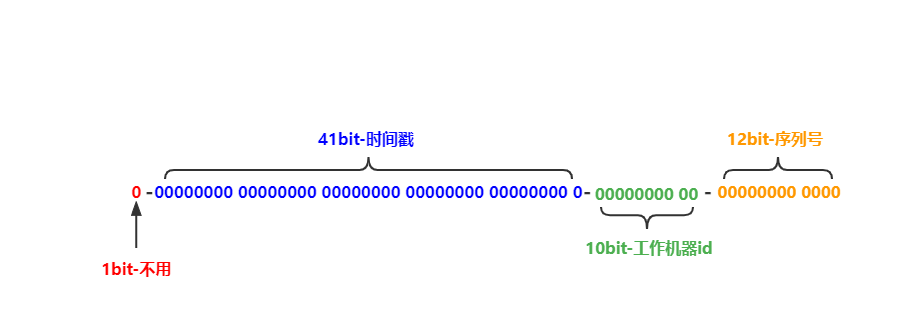我们现在大多 MySQL 数据库,生成 ID 的算法就是用的 SnowFlake,下面我们了解一下这个算法的生成原理,以及是如何工作的👀
# SnowFlake 算法
SnowFlake 是 twitter 公司内部分布式项目采用的 ID 生成算法,开源后广受国内大厂的好评。由这种算法生成的 ID,我们就叫做 SnowFlakeID。
SnowFlake 算法生成 id 的结果是一个 64bit 大小的整数,它的结构如下图:
分为四段:
第一段: 1 位为未使用,永远固定为 0。
(因为二进制中最高位是符号位,1 表示负数,0 表示正数。生成的 id 一般都是用正整数,所以最高位固定为 0 )第二段: 41 位为毫秒级时间 (41 位的长度可以使用 69 年)
第三段: 10 位为 workerId (10 位的长度最多支持部署 1024 个节点)
(这里的 10 位又分为两部分,第一部分 5 位表示数据中心 ID(0-31)第二部分 5 位表示机器 ID(0-31))第四段: 12 位为毫秒内的计数(12 位的计数顺序号支持每个节点每毫秒产生 4096 个 ID 序号)
代码实现:😎
import java.util.HashSet; | |
import java.util.concurrent.atomic.AtomicLong; | |
public class SnowFlake { | |
// 时间 41 位 | |
private static long lastTime = System.currentTimeMillis(); | |
// 数据中心 ID 5 位 (默认 0-31) | |
private long datacenterId = 0; | |
private long datacenterIdShift = 5; | |
// 机房机器 ID 5 位 (默认 0-31) | |
private long workerId = 0; | |
private long workerIdShift = 5; | |
// 随机数 12 位 (默认 0~4095) | |
private AtomicLong random = new AtomicLong(); | |
private long randomShift = 12; | |
// 随机数的最大值 | |
private long maxRandom = (long) Math.pow(2, randomShift); | |
public SnowFlake() { | |
} | |
public SnowFlake(long workerIdShift, long datacenterIdShift){ | |
if (workerIdShift < 0 || | |
datacenterIdShift < 0 || | |
workerIdShift + datacenterIdShift > 22) { | |
throw new IllegalArgumentException("参数不匹配"); | |
} | |
this.workerIdShift = workerIdShift; | |
this.datacenterIdShift = datacenterIdShift; | |
this.randomShift = 22 - datacenterIdShift - workerIdShift; | |
this.maxRandom = (long) Math.pow(2, randomShift); | |
} | |
// 获取雪花的 ID | |
private long getId() { | |
return lastTime << (workerIdShift + datacenterIdShift + randomShift) | | |
workerId << (datacenterIdShift + randomShift) | | |
datacenterId << randomShift | | |
random.get(); | |
} | |
// 生成一个新的 ID | |
public synchronized long nextId() { | |
long now = System.currentTimeMillis(); | |
// 如果当前时间和上一次时间不在同一毫秒内,直接返回 | |
if (now > lastTime) { | |
lastTime = now; | |
random.set(0); | |
return getId(); | |
} | |
// 将最后的随机数,进行 + 1 操作 | |
if (random.incrementAndGet() < maxRandom) { | |
return getId(); | |
} | |
// 自选等待下一毫秒 | |
while (now <= lastTime) { | |
now = System.currentTimeMillis(); | |
} | |
lastTime = now; | |
random.set(0); | |
return getId(); | |
} | |
// 测试 | |
public static void main(String[] args) { | |
SnowFlake snowFlake = new SnowFlake(); | |
HashSet<Long> set = new HashSet<>(); | |
for (int i = 0; i < 10000; i++) { | |
set.add(snowFlake.nextId()); | |
} | |
System.out.println(set.size()); | |
} | |
} |
代码中获取 id 的方法利用位运算实现

1 | 41 | 5 | 5 | 12 | |
0|0001100 10100010 10111110 10001001 01011100 00|00000|0 0000|0000 00000000 //41位的时间 | |
0|0000000 00000000 00000000 00000000 00000000 00|10001|0 0000|0000 00000000 //5位的数据中心ID | |
0|0000000 00000000 00000000 00000000 00000000 00|00000|1 1001|0000 00000000 //5为的机器ID | |
or 0|0000000 00000000 00000000 00000000 00000000 00|00000|0 0000|0000 00000000 //12位的sequence | |
------------------------------------------------------------------------------------------ | |
0|0001100 10100010 10111110 10001001 01011100 00|10001|1 1001|0000 00000000 //结果:910499571847892992 |
# SnowFlake 优点:
- 所有生成的 id 按时间趋势递增
- 整个分布式系统内不会产生重复 id(因为有 datacenterId 和 workerId 来做区分)
# SnowFlake 不足:
由于 SnowFlake 强依赖时间戳,所以时间的变动会造成 SnowFlake 的算法产生错误。